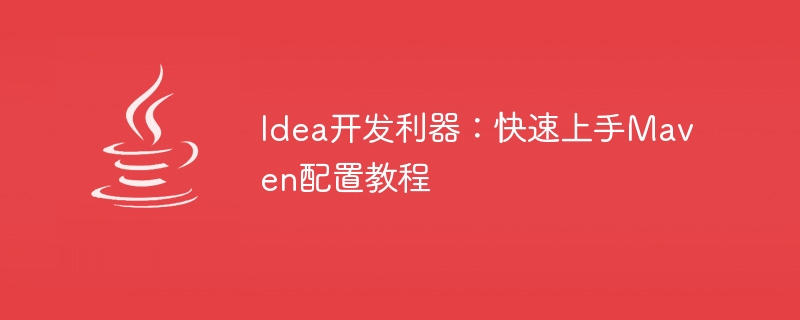Home >Java >javaTutorial >A solid and concise Maven configuration guide: Let you quickly master the development tool of Idea
A solid and concise Maven configuration guide: Let you quickly master the development tool of Idea
- WBOYWBOYWBOYWBOYWBOYWBOYWBOYWBOYWBOYWBOYWBOYWBOYWBOriginal
- 2024-01-28 09:03:081405browse

Idea Development Tool: Quick Start Maven Configuration Tutorial
Introduction:
For Java developers, Maven is a very commonly used project Build tools and dependency management tools. It can help developers automatically build projects, manage dependencies, and provide rich plug-ins to support various development tasks. This article will introduce you how to quickly get started with Maven and provide specific code examples to help you fully utilize the power of Maven in development.
Part One: Maven Installation and Configuration
First, we need to install Maven locally. You can download the latest Maven version from the Maven official website (https://maven.apache.org/) and complete the installation process by referring to the official documentation.
After the installation is complete, we need to configure Maven's environment variables. In the Windows operating system, please add the Maven installation path to the system's Path variable; in the Mac or Linux operating system, use the following command in the terminal to configure:
export PATH=/path/to/maven/bin:$PATH
Next, we can pass Run the following command to verify whether Maven is successfully installed and configured:
mvn -v
If you can see the Maven version information, the installation and configuration are successful.
Part 2: Create a Maven project
Now we start to create a new Maven project. Open your favorite IDE (such as IntelliJ IDEA) and select New Project.
In the process of creating a new project, select the Maven project type and fill in the relevant project information, such as Group Id, Artifact Id and version number.
Once the project is created, you will find that a file named pom.xml is generated in the root directory of the project. This file is the core configuration file of the Maven project and is used to define the project's build information and dependencies.
Part 3: Configure project dependencies
Next, we need to add the required dependencies in the pom.xml file. One of Maven's advantages is its ability to automatically manage project dependencies and download the required jar packages through the central repository (Maven Central Repository).
In the pom.xml file, add a
<dependencies>
<dependency>
<groupId>org.springframework</groupId>
<artifactId>spring-core</artifactId>
<version>5.3.8</version>
</dependency>
<dependency>
<groupId>org.springframework</groupId>
<artifactId>spring-web</artifactId>
<version>5.3.8</version>
</dependency>
</dependencies>After saving the pom.xml file, Maven will automatically download and install these dependencies.
Part 4: Compile and Build the Project
Now we can use Maven to compile and build the project. Open a terminal or IDE's command line interface and navigate to the root directory of your project.
Run the following command to compile the project:
mvn compile
Maven will automatically find the source code file of the project and compile it into a bytecode file.
If the project contains unit tests, you can use the following command to run the tests:
mvn test
Finally, we can use the following command to build the project's executable file (such as a jar package):
mvn package
Maven will save the project's build output in the target directory.
Conclusion:
This article introduces you how to quickly get started with Maven, and provides specific code examples to help you give full play to the power of Maven in development. I hope that this article will give you a deeper understanding of the configuration and use of Maven, and enable you to use this powerful tool more efficiently in future development. I wish you better development results in using Maven!
The above is the detailed content of A solid and concise Maven configuration guide: Let you quickly master the development tool of Idea. For more information, please follow other related articles on the PHP Chinese website!

